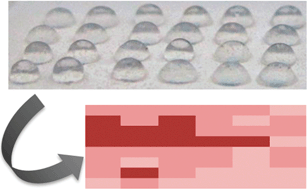Combinatorial cell–3D biomaterials cytocompatibility screening for tissue engineering using bioinspired superhydrophobic substrates†
Abstract
We report on the development of a new array-based screening flat platform with the potential to be used as a high-throughput device based on biomimetic polymeric substrates for combinatorial cell/3D biomaterials screening assays in the context of tissue engineering. Polystyrene was used to produce superhydrophobic surfaces based on the so-called lotus effect. Arrays of hydrophilic regions could be patterned in such surfaces using UV/ozone radiation, generating devices onto which combinatorial hydrogel spots were deposited. The biological performance of encapsulated cells in hydrogels could be tested in an in vitro 3D environment assuming that each site was isolated from the others due to the high contrast of wettability between the patterned spots and the superhydrophobic surroundings. Three different


 Please wait while we load your content...
Please wait while we load your content...